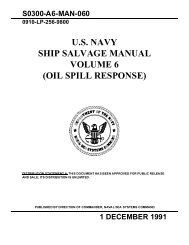FACEPLATE FNL (April 2004) - Supervisor of Salvage and Diving
FACEPLATE FNL (April 2004) - Supervisor of Salvage and Diving
FACEPLATE FNL (April 2004) - Supervisor of Salvage and Diving
You also want an ePaper? Increase the reach of your titles
YUMPU automatically turns print PDFs into web optimized ePapers that Google loves.
BMCS(DSW/SS) Bingham coming up through TR-73’s<br />
pilothouse after conducting first internal inspection.<br />
Once inside, the lift bags were inflated.<br />
Four mooring buoys were rigged outside<br />
the TR-73 for added lift. Additionally,<br />
c<strong>of</strong>ferdams were placed on various fuel<br />
fittings to prevent leakage <strong>of</strong> an estimated<br />
500 gallons <strong>of</strong> DFM.<br />
On January 19, the TR-73 was successfully<br />
lifted <strong>and</strong> towed 200 feet from the<br />
rocks to her safe haven - a mooring buoy.<br />
The starboard had massive damage to its<br />
aft portion. Several tons <strong>of</strong> s<strong>and</strong> were<br />
found within the aft compartment. The<br />
Divers began removing s<strong>and</strong> using trash<br />
pumps <strong>and</strong> h<strong>and</strong> buckets which improved<br />
TR-73’s buoyancy. Although successfully<br />
lifted, damage was too extensive to safely<br />
tow the craft to Oahu, some 100 miles away.<br />
The decision was made by PRMF to use<br />
A view <strong>of</strong> the damage to the starboard aft engine room<br />
during the initial grounding.<br />
an excavator for disposal<br />
once the vessel<br />
was safely retracted<br />
ashore.<br />
Prior to the arrival<br />
<strong>of</strong> the excavator, heavy<br />
swells <strong>and</strong> adverse<br />
weather continued over<br />
the next several days,<br />
breaking over a dozen<br />
wire pennants designed<br />
to hold the craft in<br />
place.<br />
Additionally,<br />
several lift bags were<br />
punctured by hull<br />
damage <strong>and</strong> eventually<br />
leaked. The Divers<br />
performed multiple in-water repairs<br />
on the lift bags inside TR-73 <strong>and</strong> rerigged<br />
the craft for retraction.<br />
On January 25, the excavator arrived<br />
on site <strong>and</strong> the Team set up<br />
the retraction <strong>and</strong> recovery gear on<br />
a ridge near the Port Allen harbor.<br />
Though several wire pennants broke<br />
during the beaching process, the TR-<br />
73 was successfully retracted onto<br />
shore on the evening <strong>of</strong> January 27.<br />
The next morning, the Team retrieved<br />
lift bags <strong>and</strong> rigging from TR-73,<br />
packed their gear, <strong>and</strong> prepared for<br />
redeployment to Oahu. TR-73, totally<br />
beyond repair, was eventually<br />
sold for scrap.<br />
“As my first salvage job at<br />
MDSU ONE, I<br />
would say this was a<br />
very frustrating <strong>and</strong><br />
challenging job because<br />
it required lots <strong>of</strong> rethinking<br />
<strong>and</strong> looking at different<br />
ways <strong>of</strong> doing things<br />
to get that boat out <strong>of</strong> the<br />
water,” said BM2 Joseph<br />
Theodorou, a MDSU<br />
ONE Det 3 Diver. “It<br />
took a lot to get the<br />
TR-73 out <strong>of</strong> there,<br />
but the team work was<br />
great <strong>and</strong> the support we<br />
received from the PMRF<br />
personnel was the best.”<br />
After putting in internal flotation devices <strong>and</strong><br />
with the amount <strong>of</strong> s<strong>and</strong> retained while aground<br />
on rocks, more external flotation devices were<br />
required for the port aft corner.<br />
Team MDSU displayed the mobility<br />
<strong>and</strong> flexibility <strong>of</strong>ten needed in salvage<br />
operations to successfully recover the TR-<br />
73. Being able to deploy a rapid response<br />
dive team <strong>and</strong> its equipment via helicopter<br />
exhibited a new level <strong>of</strong> mobility previously<br />
unheard <strong>of</strong> in the salvage Navy <strong>and</strong> further<br />
validated MDSU’s role in Expeditionary<br />
<strong>Diving</strong> <strong>and</strong> <strong>Salvage</strong>. Indeed, MDSU ONE<br />
Det 3 was able to successfully complete its<br />
mission in spite <strong>of</strong> short notice <strong>of</strong> tasking,<br />
rough seas, <strong>and</strong> damaged equipment.<br />
MDSU ONE Det 3 Officer-in-Charge,<br />
BMCS(DSW/SS) Wade Bingham,stated<br />
that: “All branches <strong>of</strong> the dive Navy make<br />
plans <strong>and</strong> implement them. Usually<br />
though, if an obstacle presents, the<br />
inclination for most is to turn back <strong>and</strong> rethink<br />
or re-plan. On the salvage side <strong>of</strong><br />
the house though, turning back is<br />
not an option, the job has to get done.<br />
Re-thought strategies, onsite ingenuity,<br />
<strong>and</strong> relentless persistence are necessary<br />
to do that job. Obstacles do not show<br />
up on the planning board, so we<br />
have to overcome them out there on<br />
the side.”<br />
Team MDSU adds another successful<br />
operation to their report card. HOO YAH -<br />
Go Navy Divers!<br />
LT Todd Ochsner is currently the DMO/<br />
PAO at MDSU ONE.<br />
A u g u s t 2 0 0 4 1 9

















